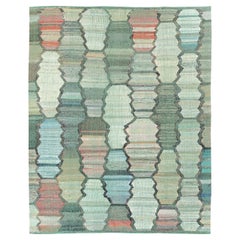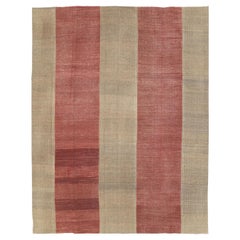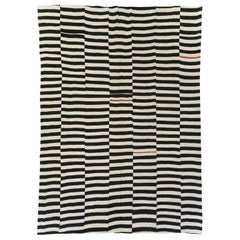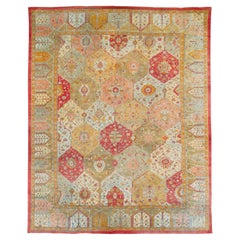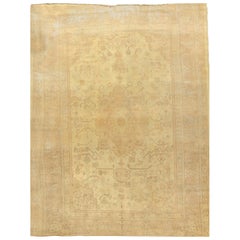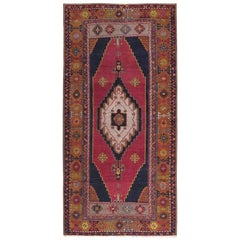Manhattan - Turkish Rugs
to
742
Width
to
Length
to
3,878
398
113
357
283
71
34
29
28
21
20
17
16
15
5
1
8
256
3,614
511
867
1,782
171
63
46
114
102
146
158
155
41
5
6
4,381
4,293
409
201
201
4,389
24,215
1,685
4,389
4,387
4,387
3,797
3,747
3,610
3,589
136
23
16
1
1
Item Ships From: Manhattan
Contemporary Turkish Flat-Weave Kilim Large Room Size Carpet
Located in New York, NY
A modern Turkish flat-weave Kilim large room size carpet handmade during the 21st century.
Measures: 13' 2" x 16' 6"
Flat-weave rugs & carpets:
Knotted pile rugs are just one small part of a vast universe of textile techniques suitable for heavy use. If you can imagine it, some weaver has tried it out. Pieces can be roughly divided into those reversible from the start and those never, or at least not initially, reversible. Thus, kilims are considered reversible, while everything else is not.
Kilims are tapestry woven rugs with both sides the same, in either slit technique where colors change, or with various methods of avoiding slits. Slit tapestry weave goes back to ancient times and Coptic...
Category
21st Century and Contemporary Turkish Modern Manhattan - Turkish Rugs
Materials
Wool
Mid-20th Century Handmade Turkish Flatweave Kilim Room Size Carpet
Located in New York, NY
A vintage Turkish flatweave Kilim room size carpet handmade during the mid-20th century.
Measures: 10' 1" x 13' 2".
Category
Mid-20th Century Turkish Rustic Manhattan - Turkish Rugs
Materials
Wool
21st Century Modern Handmade Turkish Flatweave Kilim Room Size Carpet
Located in New York, NY
A modern Turkish flatweave Kilim room size carpet handmade during the 21st century.
Measures: 9' 10" x 13' 10"
Category
21st Century and Contemporary Turkish Tribal Manhattan - Turkish Rugs
Materials
Wool
Early 20th Century Turkish Oushak Large Carpet
Located in New York, NY
An antique Turkish Oushak large carpet. This attractive west Anatolian workshop carpet artistically combines two design traditions. The field pattern of hexagonal tiles in cream, gol...
Category
Early 20th Century Turkish Oushak Manhattan - Turkish Rugs
Materials
Wool
Antique Shabby Chic Oushak Rug, circa 1920 8'11 x 11'10
Located in New York, NY
Antique shabby chic Oushak rug, circa 1920 8'11 x 11'10. Light-colored Oushaks are among the most popular oriental carpets, known for the high quality of their wool their beautiful ...
Category
20th Century Turkish Manhattan - Turkish Rugs
Materials
Wool
Yahyali Rug
Located in New York, NY
Yahyali rug. Rug is a superb example of Anatolian weaving tradition in the early 20th century. A very refined interpretation of this design, rug has highly...
Category
Early 20th Century Turkish Manhattan - Turkish Rugs
Materials
Wool
$5,200 Sale Price
20% Off
Contemporary Handmade Turkish Flatweave Kilim Accent Rug
Located in New York, NY
A modern Turkish flatweave Kilim accent rug handmade during the 21st century.
Measures: 6' 8" x 9' 7".
Category
21st Century and Contemporary Turkish Modern Manhattan - Turkish Rugs
Materials
Wool
Antique 1880s Turkish Oushak Rug, Wool, Red, 14' x 16'
Located in New York, NY
This Turkish Oushak carpet created circa 1880 consists of a handspun wool warp, weft and hand-knotted pile. It is an exceptional example of an Oushak made for internal use, which is ...
Category
19th Century Turkish Oushak Antique Manhattan - Turkish Rugs
Materials
Wool
Mid-20th Century Handmade Turkish Art Deco Style Runner
Located in New York, NY
A vintage Turkish Art Deco style runner handmade during the mid-20th century.
Measures:
Category
Mid-20th Century Turkish Art Deco Manhattan - Turkish Rugs
Materials
Wool
Zabihi Collection Neutral Turkish Yastik Rug
Located in New York, NY
A vintage Anatolian Turkish Yastik rug mat
Measures: 1'6” x 3'2”
Category
20th Century Turkish Gustavian Manhattan - Turkish Rugs
Materials
Wool
Antique Turkish Oushak Rug
Located in New York, NY
An antique Turkish Oushak carpet from the second quarter of the 20th century.
Category
1930s Turkish Oushak Vintage Manhattan - Turkish Rugs
Materials
Wool
$19,600
Antique Kula Rug 4' 0" x 6' 4"
Located in New York, NY
Antique Turkish Kula rug, size: 4'0" x 6'4".
Category
Mid-18th Century Turkish Antique Manhattan - Turkish Rugs
Materials
Wool
Mid-20th Century Turkish Anatolian Room Size Rug
Located in New York, NY
A vintage Turkish Anatolian tribal room size carpet handmade during the mid-20th century.
Measures: 9' 1" x 15' 3".
Category
Mid-20th Century Turkish Tribal Manhattan - Turkish Rugs
Materials
Wool
Vintage Turkish Art Deco Runner
Located in New York, NY
A vintage Turkish Art Deco runner handmade during the mid-20th century.
Category
Mid-20th Century Turkish Art Deco Manhattan - Turkish Rugs
Materials
Wool
Mid-20th Century Turkish Flatweave Kilim Room Size Carpet
Located in New York, NY
This Mid-20th century Turkish Flatweave Kilim rug, measuring 9' 5" x 10' 3", features a classic horizontal striped design, skillfully woven in a natural palette of earthy browns, sof...
Category
Mid-20th Century Turkish Kilim Manhattan - Turkish Rugs
Materials
Wool
Vintage Turkish Tulu Rug
Located in New York, NY
A vintage Tulu Turkish rug from the mid-20th century. A wide plain saturated marsala colored border with a beige open field. No ditzy ornamentation. Totally graphic with a very long ...
Category
Mid-20th Century Turkish Folk Art Manhattan - Turkish Rugs
Materials
Wool
$1,900 Sale Price
20% Off
Antique Turkish Oushak Rug
Located in New York, NY
An antique Turkish Oushak carpet from the second quarter of the 20th century.
Category
1930s Turkish Oushak Vintage Manhattan - Turkish Rugs
Materials
Wool
Contemporary Handmade Turkish Flatweave Kilim Room Size Carpet
Located in New York, NY
A modern Turkish flatweave Kilim room size carpet handmade during the 21st century.
Measures: 11' 2" x 14' 2".
Category
21st Century and Contemporary Turkish Modern Manhattan - Turkish Rugs
Materials
Wool
Vintage Moroccan Style Fluffy Net Rug 9'x12'2
Located in New York, NY
Vintage Moroccan Style Fluffy Net Rug 9'x12'2. Exotic, chic, and wonderfully versatile, Moroccan rugs continue to soar in popularity, seducing design aficionados with their patterns...
Category
21st Century and Contemporary Indian Manhattan - Turkish Rugs
Materials
Wool
Antique Turkish Sivas Carpet
Located in New York, NY
An antique Turkish Sivas carpet from the early 20th century.
Measures: 9' 11" x 14' 5"
Category
Early 20th Century Persian Tabriz Manhattan - Turkish Rugs
Materials
Wool
$27,500
Vintage Oushak in Rose Pink Tones
Located in New York, NY
ref 78596
Category
Early 20th Century Turkish Oushak Manhattan - Turkish Rugs
Materials
Wool
$8,000 Sale Price
20% Off
Vintage Turkish Kars with Ecru Field and Zig Zag Border
Located in New York, NY
Kars carpets show individuality with almost no two identical. This one, for example, shows two columns of hooked hexagons enclosing mostly ecru ashiks, on a natural sandy tan ground. Narrow red zig...
Category
Mid-20th Century Turkish Manhattan - Turkish Rugs
Materials
Wool
Vintage Turkish Oushak Runner 2'9 x 12'5
Located in New York, NY
Vintage Turkish Oushak Runner 2'9 X 12'5. Oushak's are known for their soft palettes combined with eccentric drawing. Oushak in western Turkey has the longest continuous rug weaving ...
Category
20th Century Turkish Oushak Manhattan - Turkish Rugs
Materials
Wool
Contemporary Handmade Turkish Patchwork Style Flatweave Throw Rug
Located in New York, NY
A modern Turkish Patchwork style flatweave throw rug handmade during the 21st century using remnants of vintage Turkish flatweaves from the mid-20th century.
Measures: 3' 1" x 4' 2".
Category
21st Century and Contemporary Turkish Modern Manhattan - Turkish Rugs
Materials
Wool
Vintage Oushak Runner, Mid-20th Century
Located in New York, NY
This vintage runner is a simple study in medium brown and khaki with shadow details in golden tan. The condition is low and somewhat distressed.
Category
Mid-20th Century Turkish Oushak Manhattan - Turkish Rugs
Materials
Wool
Late 19th Century Turkish Oushak Carpet ( 9' 2'' x 12' 280 x 366 )
Located in New York, NY
Late 19th Century Turkish Oushak Carpet ( 9' 2'' x 12' 280 x 366 )
Category
1880s Turkish Oushak Antique Manhattan - Turkish Rugs
Materials
Wool
Vintage Square Oushak with a Rust Red Field and an Ecru Medallion
Located in New York, NY
Better woven than most Oushaks, this room size shows a twelve point medallion with ecru sub-medallion, on an abrashed rust-red field, with an even supporting cast of palmettes, and t...
Category
Mid-20th Century Turkish Manhattan - Turkish Rugs
Materials
Wool
Antique Turkish Oushak Rug, Sage Green Field, Light Pink Borders, circa 1920s
Located in New York, NY
The very pale green field shows a palmette and branches open small medallion connected to open work pendants. Ecru forked arabesques define the straw palmette quarter corners. Light pink palmette...
Category
1920s Turkish Oushak Vintage Manhattan - Turkish Rugs
Materials
Wool
Vintage Kars Rug with Shades of Brown and Chocolate Brown Center Medallion
Located in New York, NY
This rustic creation features a light brown, abrashed semi-open field focused on a pendanted chocolate medallion with a central, nested octofoil motif in ecru and brick. Convex choc...
Category
Mid-20th Century Turkish Manhattan - Turkish Rugs
Materials
Wool
Contemporary Handmade Turkish Flat-Weave Kilim Large Geometric Room Size Carpet
Located in New York, NY
A modern Turkish flat-weave Kilim large room size carpet handmade during the 21st century with a geometric large scale diamond-shaped pattern in earth tones with an overall khaki gre...
Category
21st Century and Contemporary Turkish Modern Manhattan - Turkish Rugs
Materials
Wool
Nazmiyal Collection Modern Greek Key Influenced Rug 9'3" x 15'
Located in New York, NY
Elegant Modern Greek Key Influenced Contemporary Rug, Country of origin: Turkey, Circa date: Modern
Category
21st Century and Contemporary Modern Manhattan - Turkish Rugs
Materials
Wool
Mid-20th Century Handmade Turkish Flat-Weave Kilim Room Size Carpet
Located in New York, NY
A vintage Turkish flat-weave Kilim room size carpet handmade during the mid-20th century.
Measures: 10' 5" x 14' 2"
Flat-weave rugs & carpets:
Knotted pile rugs are just one small part of a vast universe of textile techniques suitable for heavy use. If you can imagine it, some weaver has tried it out. Pieces can be roughly divided into those reversible from the start and those never, or at least not initially, reversible. Thus, kilims are considered reversible, while everything else is not.
Kilims are tapestry woven rugs with both sides the same, in either slit technique where colors change, or with various methods of avoiding slits. Slit tapestry weave goes back to ancient times and Coptic...
Category
Mid-20th Century Turkish Modern Manhattan - Turkish Rugs
Materials
Wool
Contemporary Turkish Flat-Weave Accent Rug Inspired by Swedish Kilims
Located in New York, NY
A modern Turkish flat-weave accent rug handmade during the 21st century. The design and weave are inspired by vintage Swedish Kilim rugs from the mid-20th century period.
Measures...
Category
21st Century and Contemporary Turkish Scandinavian Modern Manhattan - Turkish Rugs
Materials
Wool
$4,900 Sale Price
20% Off
Contemporary Handmade Turkish Flatweave Kilim Oversize Carpet
Located in New York, NY
A contemporary Turkish flatweave Kilim large oversize carpet handmade during the 21st century.
Measures: 16' 0" x 20' 8".
Category
21st Century and Contemporary Turkish Modern Manhattan - Turkish Rugs
Materials
Wool
Vintage Handmade Turkish Flat-Weave Kilim Accent Rug
Located in New York, NY
A vintage Turkish flat-weave Kilim accent rug handmade during the mid-20th century.
Measures: 6' 5" x 10' 8".
Category
Mid-20th Century Turkish Mid-Century Modern Manhattan - Turkish Rugs
Materials
Wool
Vintage Turkish Anatolian Carpet
Located in New York, NY
A vintage Turkish Anatolian carpet from the mid-20th century.
Category
Mid-20th Century Turkish Tribal Manhattan - Turkish Rugs
Materials
Wool
Early 20th Century Turkish Cotton Kayseri Carpet ( 9' x 12'6" - 275 x 380 )
Located in New York, NY
Early 20th Century Turkish Cotton Kayseri Carpet ( 9' x 12'6" - 275 x 380 )
Category
1920s Turkish Vintage Manhattan - Turkish Rugs
Materials
Cotton
Galerie Shabab Collection Moroccan Inspired Modern Turkish Room Size Carpet
Located in New York, NY
A modern Turkish large carpet with tassels and braided fringes. Handmade during the 21st century, this carpet is inspired by vintage Moroccan carpets from the Mid-20th Century period...
Category
21st Century and Contemporary Turkish Modern Manhattan - Turkish Rugs
Materials
Wool
Contemporary Turkish Flatweave Patchwork Throw Rug
Located in New York, NY
A contemporary Turkish flatweave Kilim throw rug handmade during the 21st century. This patchwork-style rug consists of hand-weaving together several...
Category
21st Century and Contemporary Turkish Modern Manhattan - Turkish Rugs
Materials
Wool
Galerie Shabab Collection Mid-20th Century Turkish Tribal Room Size Carpet
Located in New York, NY
A vintage Turkish Anatolian tribal room size carpet handmade during the Mid-20th Century.
Measures: 9' 11" x 12' 10".
Category
Mid-20th Century Turkish Tribal Manhattan - Turkish Rugs
Materials
Wool
Mid-20th Century Handmade Turkish Flat-Weave Kilim Room Size Carpet
Located in New York, NY
A vintage Turkish flat-weave Kilim room size carpet handmade during the mid-20th century.
Measures: 10' 5" x 13' 5"
Flat-weave rugs & carpets:
Knotted pile rugs are just one small part of a vast universe of textile techniques suitable for heavy use. If you can imagine it, some weaver has tried it out. Pieces can be roughly divided into those reversible from the start and those never, or at least not initially, reversible. Thus, kilims are considered reversible, while everything else is not.
Kilims are tapestry woven rugs with both sides the same, in either slit technique where colors change, or with various methods of avoiding slits. Slit tapestry weave goes back to ancient times and Coptic Egyptian weavers used it for ornaments on garments and larger wall hangings. Slits can be avoided by dovetailing of colors (warp sharing) or by interlocking the wefts. The Navajo weavers of the Southwest practice the first while the fine shawl weavers of Kashmir and Kerman employed the second. Interlocking produces a one-faced fabric, with smooth and rough, ridged faces. The typical Turkish, Caucasian, or Persian rustic kilim shows slits, but never long ones. Aubusson French carpets are also slit tapestries and the long color transitions are sewn up as part of the regular maintenance. Some kilims are very fine. The best antique urban Sehna (Senna) kilims on wool, cotton or silk warps approximate the comparable rugs in refinement and are the most desirable of all Persian kilims. Although the various flatweave techniques are usually expressed in geometric, simple, often repeating, patterns, Sehna kilims demonstrate that even the most intricate designs can be effectively rendered in flat-stich. The term ‘kilim’ has been extended to cover any pileless, weft-faced heavy textile. Thus, the sectioned and joined northeastern Persian horizontally striped wool rugs are called ‘kilims’. So are the plain-weave end finishes of pile rugs. All these are weft-faced, weft patterned flatweaves.
These sectioned pieces are woven not on a frame loom, but one steadied by the weaver at one end and with the warps fastened down at the other. Only relatively recent have these tribal pieces become available. They are used as floorcoverings, hangings, room dividers, furniture covers. They are mostly bitonal in shades of natural dark brown and beige. Some more recent pieces show weaver innovations with ikat and moire effects. Work proceeds quickly and a skilled weaver can complete a thirty foot strip in almost no time.
Wefts, the elements added as weaving progresses, play an essential part in what is a flatweave. The best-known example of an extra-weft, wrapping technique is on Caucasian and tribal Persian Soumaks, where a pattern weft wraps around the fixed warp, changing as weaving progresses. Soumaks can be large carpets, Kuba in the Caucasus, small bag faces (Caucasian and Persian Shah Savan saddle bags), or cover scatter rugs (Persian Afshars). The Soumak technique is fast, and a weaver can work much more quickly than tying knots. The left-over wefts are cut off on the back, so the front and back are initially different. As a Soumak on the floor gets used, these weft yarns wear away and the two sides converge although the exact texture remains distinct.
There are other ways of pattern by weft. Often on smaller tribal pieces, the pattern weft(s) is (are) part of the weft structure, moving in an out, and holding the whole thing together. These wefts can be complementary or added (supplementary), continuous across the flatweave or cut off as they travel unneeded across the verso. Supplementary weft flatweaves are often very compact and substantial. The nomadic Turkmen and Balouch tribes employ both supplementary and complementary weft techniques on their pieces. Supplementary wefts are often raised on the recto (front) while complementary wefts are flat to the surface. Tribal Kurds employ this extra-wefting technique. The Balouch of Pakistan use complementary wefts almost exclusively on their small woven paraphernalia like salt bags.
Flatweave techniques may be combined on a single piece. Afshar rugs employ plain-weave end strips, preceded by Soumak bands, with pile sections between. The large Bakhtiari saddlebags feature Soumak work, pile “islands” an areas of plain-weave. Qashqai rugs and kilims frequently displays checkerboard end strips in continuous, complementary wefting.
Another distinct flatweave type is the jajim (jijim, cecim) in which a pattern is added with colored wefts as the weaving of the plain-weave ground progresses. Here the wefts are discontinuous and the pattern stands proud from the voided ground. Often made in two pieces on narrow looms and edge-sewn together, these may have geometric patterns. The term ‘jajim’ also refers to the assembled warp-faced strip and stripe covers from the Shah Savan of northwest Persia, the pattern is defined by warps alone, usually in plain stripes, but sometimes in designs of ladders, snakes, human figures and various animals. Here the color changing warps are continuous. Most are wool, a few are silk. Better to call these something else.
Indian ‘Dhurries’ are all cotton kilims and ‘shatrangis’ employ wool wefts on cotton warps. Dhurries are slitless. The cotton texture is more appropriate to the humid and warm climate of the Indian subcontinent. Modern Dhurries...
Category
Mid-20th Century Turkish Modern Manhattan - Turkish Rugs
Materials
Wool
White & Beige Contemporary Handmade Turkish Flatweave Kilim Room Size Carpet
Located in New York, NY
A contemporary Turkish flatweave Kilim large room size carpet handmade during the 21st century in shades of white and beige. This patchwork style rug consists of hand-weaving togethe...
Category
21st Century and Contemporary Turkish Modern Manhattan - Turkish Rugs
Materials
Wool
Antique Morrocan Oriental Rug, in Room Size, with a Central Medallion
Located in New York, NY
Antique Moroccan Rug, circa 1920, Room size.
A one-of-a-kind antique Moroccan Rug, hand-knotted with medium thickness wool pile. This beautiful rug features a central medallion d...
Category
1920s Vintage Manhattan - Turkish Rugs
Materials
Wool
$10,396 Sale Price
20% Off
Antique Turkish Ghiordes Rug
Located in New York, NY
An antique Turkish Ghiordes carpet from the first quarter of the 20th century.
Category
1920s Turkish Oushak Vintage Manhattan - Turkish Rugs
Materials
Wool
$2,080 Sale Price
20% Off
Zabihi Collection Turkish Square Rug Pillow
Located in New York, NY
Pillow made from an early 20th century turkish rug. poly fill insert provided with a zipper closure
16'' x 16''
Category
Early 20th Century Country Manhattan - Turkish Rugs
Materials
Wool
$140 Sale Price
53% Off
Early 20th Century Turkish Oushak Carpet 9' 2" x 22' 4"
Located in New York, NY
Antique Turkish Oushak Rug, Size: 9' 2" x 22' 4"
Category
1910s Turkish Vintage Manhattan - Turkish Rugs
Materials
Wool
Title: Antique Hand-Knotted Sivas Rug – Subtle Distressed Elegance
Located in New York, NY
This antique Sivas rug embodies understated sophistication with its soft neutral palette, featuring warm beige, ivory, and pale gray tones that blend seamlessly into a delicately fad...
Category
Early 20th Century Manhattan - Turkish Rugs
Materials
Wool
Mid-20th Century Handmade Turkish Flat-Weave Kilim Accent Carpet
Located in New York, NY
A vintage Turkish flat-weave Kilim accent carpet handmade during the mid-20th century.
Measures: 6' 10" x 9' 7"
Flat-weave rugs & carpets:
Knotted pile rugs are just one small part of a vast universe of textile techniques suitable for heavy use. If you can imagine it, some weaver has tried it out. Pieces can be roughly divided into those reversible from the start and those never, or at least not initially, reversible. Thus, kilims are considered reversible, while everything else is not.
Kilims are tapestry woven rugs with both sides the same, in either slit technique where colors change, or with various methods of avoiding slits. Slit tapestry weave goes back to ancient times and Coptic Egyptian weavers used it for ornaments on garments and larger wall hangings. Slits can be avoided by dovetailing of colors (warp sharing) or by interlocking the wefts. The Navajo weavers of the Southwest practice the first while the Fine shawl weavers of Kashmir and Kerman employed the second. Interlocking produces a one-faced fabric, with smooth and rough, ridged faces. The typical Turkish, Caucasian, or Persian rustic Kilim shows slits, but never long ones. Aubusson French carpets are also slit tapestries and the long color transitions are sewn up as part of the regular maintenance. Some kilims are very Fine. The best antique urban Sehna (Senna) kilims on wool, cotton or silk warps approximate the comparable rugs in refinement and are the most desirable of all Persian kilims. Although the various flatweave techniques are usually expressed in geometric, simple, often repeating, patterns, Sehna kilims demonstrate that even the most intricate designs can be effectively rendered in flat-stich. The term ‘Kilim’ has been extended to cover any pileless, weft-faced heavy textile. Thus, the sectioned and joined northeastern Persian horizontally striped wool rugs are called ‘kilims’. So are the plain-weave end finishes of pile rugs. All these are weft-faced, weft patterned flatweaves.
These sectioned pieces are woven not on a frame loom, but one steadied by the weaver at one end and with the warps fastened down at the other. Only relatively recent have these tribal pieces become available. They are used as floorcoverings, hangings, room dividers, furniture covers. They are mostly bitonal in shades of natural dark brown and beige. Some more recent pieces show weaver innovations with ikat and moire effects. Work proceeds quickly and a skilled weaver can complete a thirty foot strip in almost no time.
Wefts, the elements added as weaving progresses, play an essential part in what is a flatweave. The best-known example of an extra-weft, wrapping technique is on Caucasian and tribal Persian Soumaks, where a pattern weft wraps around the fixed warp, changing as weaving progresses. Soumaks can be large carpets, Kuba in the Caucasus, small bag faces (Caucasian and Persian Shah Savan saddle bags), or cover scatter rugs (Persian Afshars). The Soumak technique is fast, and a weaver can work much more quickly than tying knots. The left-over wefts are cut off on the back, so the front and back are initially different. As a Soumak on the floor gets used, these weft yarns wear away and the two sides converge although the exact texture remains distinct.
There are other ways of pattern by weft. Often on smaller tribal pieces, the pattern weft(s) is (are) part of the weft structure, moving in an out, and holding the whole thing together. These wefts can be complementary or added (supplementary), continuous across the flatweave or cut off as they travel unneeded across the verso. Supplementary weft flatweaves are often very compact and substantial. The nomadic Turkmen and Balouch tribes employ both supplementary and complementary weft techniques on their pieces. Supplementary wefts are often raised on the recto (front) while complementary wefts are flat to the surface. Tribal Kurds employ this extra-wefting technique. The Balouch of Pakistan use complementary wefts almost exclusively on their small woven paraphernalia like salt bags.
Flatweave techniques may be combined on a single piece. Afshar rugs employ plain-weave end strips, preceded by Soumak bands, with pile sections between. The large Bakhtiari saddlebags feature Soumak work, pile “islands” an areas of plain-weave. Qashqai rugs and kilims frequently displays checkerboard end strips in continuous, complementary wefting.
Another distinct flatweave type is the jajim (jijim, cecim) in which a pattern is added with colored wefts as the weaving of the plain-weave ground progresses. Here the wefts are discontinuous and the pattern stands proud from the voided ground. Often made in two pieces on narrow looms and edge-sewn together, these may have geometric patterns. The term ‘jajim’ also refers to the assembled warp-faced strip and stripe covers from the Shah Savan of northwest Persia, the pattern is defined by warps alone, usually in plain stripes, but sometimes in designs of ladders, snakes, human figures and various animals. Here the color changing warps are continuous. Most are wool, a few are silk. Better to call these something else.
Indian ‘Dhurries’ are all cotton kilims and ‘shatrangis’ employ wool wefts on cotton warps. Dhurries are slitless. The cotton texture is more appropriate to the humid and warm climate of the Indian subcontinent. Modern Dhurries...
Category
Mid-20th Century Turkish Tribal Manhattan - Turkish Rugs
Materials
Wool
19th Century Turkish Oushak Carpet ( 10'6" x 13'5" - 320 x 415 )
Located in New York, NY
19th Century Turkish Oushak Carpet ( 10'6" x 13'5" - 320 x 415 )
In the Persian Sultanabad style, this attractive west Anatolian carpet features an old ivory field with lateral colum...
Category
1890s Turkish Oushak Antique Manhattan - Turkish Rugs
Materials
Wool
Antique Turkish Oushak Decorative Oriental Rug, in Room Size, with Muted Colors
Located in New York, NY
An antique Turkish Oushak oriental carpet, size 13'2 x 10'3, circa 1910. This lovely decorative carpet features a diffuse central medallion on a subtly hued central field, which is e...
Category
1910s Turkish Vintage Manhattan - Turkish Rugs
Materials
Wool
$22,495 Sale Price
25% Off
Mid-20th Century Handmade Turkish Flat-Weave Kilim Room Size Carpet
Located in New York, NY
A vintage Turkish flat-weave Kilim room size carpet handmade during the mid-20th century.
Measures: 10' 7" x 12' 9"
Flat-weave rugs & carpets:
Knotted pile rugs are just one small part of a vast universe of textile techniques suitable for heavy use. If you can imagine it, some weaver has tried it out. Pieces can be roughly divided into those reversible from the start and those never, or at least not initially, reversible. Thus, kilims are considered reversible, while everything else is not.
Kilims are tapestry woven rugs with both sides the same, in either slit technique where colors change, or with various methods of avoiding slits. Slit tapestry weave goes back to ancient times and Coptic...
Category
Mid-20th Century Turkish Modern Manhattan - Turkish Rugs
Materials
Wool
Contemporary Handmade Turkish Flat-Weave Kilim Colorful Large Room Size Carpet
Located in New York, NY
A modern Turkish flat-weave Kilim large room size carpet handmade during the 21st century with a colorful horizontally striped pattern. A statement piece with its bright and whimsica...
Category
21st Century and Contemporary Turkish Modern Manhattan - Turkish Rugs
Materials
Wool
$14,500 Sale Price
20% Off
Mid-20th Century Handmade Turkish Sivas Accent Rug in Cream and Mauve
Located in New York, NY
A vintage Turkish Sivas accent rug handmade during the mid-20th century with an all-over tone on tone field and border combination in cream and blonde separated and distinguished onl...
Category
Mid-20th Century Turkish Rustic Manhattan - Turkish Rugs
Materials
Wool
Mid-20th Century Handmade Turkish Flatweave Kilim Room Size Carpet
Located in New York, NY
A vintage Turkish flatweave Kilim room size carpet handmade during the mid-20th century.
Measures: 9' 11" x 13' 3".
Category
Mid-20th Century Turkish Rustic Manhattan - Turkish Rugs
Materials
Wool
Small Size Neutral Floral Design Antique Turkish Sivas Area Rug 3'9" x 5'8"
Located in New York, NY
Fine Turkish Sivas Antique rug, country of origin / type of rug: Antique Turkish rugs, date: circa 1900. Size: 3 ft 9 in x 5 ft 8 in (1.14 m x 1.73 m).
Category
Early 20th Century Turkish Oushak Manhattan - Turkish Rugs
Materials
Wool
Retro Turkish Deco Pillow
Located in New York, NY
Pillow made from a Turkish Deco rug.
Measures: 18'' x 21''.
Category
20th Century Turkish Mid-Century Modern Manhattan - Turkish Rugs
Materials
Wool, Cotton, Foam
Mid-20th Century Handmade Turkish Flat-Weave Kilim Room Size Carpet
Located in New York, NY
A vintage Turkish flat-weave Kilim room size carpet handmade during the mid-20th century.
Measures: 10' 7" x 13' 7"
Flat-weave rugs & carpets:
Knotted pile rugs are just one small part of a vast universe of textile techniques suitable for heavy use. If you can imagine it, some weaver has tried it out. Pieces can be roughly divided into those reversible from the start and those never, or at least not initially, reversible. Thus, kilims are considered reversible, while everything else is not.
Kilims are tapestry woven rugs with both sides the same, in either slit technique where colors change, or with various methods of avoiding slits. Slit tapestry weave goes back to ancient times and Coptic Egyptian weavers used it for ornaments on garments and larger wall hangings. Slits can be avoided by dovetailing of colors (warp sharing) or by interlocking the wefts. The Navajo weavers of the Southwest practice the first while the fine shawl weavers of Kashmir and Kerman employed the second. Interlocking produces a one-faced fabric, with smooth and rough, ridged faces. The typical Turkish, Caucasian, or Persian rustic kilim shows slits, but never long ones. Aubusson French carpets are also slit tapestries and the long color transitions are sewn up as part of the regular maintenance. Some kilims are very fine. The best antique urban Sehna (Senna) kilims on wool, cotton or silk warps approximate the comparable rugs in refinement and are the most desirable of all Persian kilims. Although the various flatweave techniques are usually expressed in geometric, simple, often repeating, patterns, Sehna kilims demonstrate that even the most intricate designs can be effectively rendered in flat-stich. The term ‘kilim’ has been extended to cover any pileless, weft-faced heavy textile. Thus, the sectioned and joined northeastern Persian horizontally striped wool rugs are called ‘kilims’. So are the plain-weave end finishes of pile rugs. All these are weft-faced, weft patterned flatweaves.
These sectioned pieces are woven not on a frame loom, but one steadied by the weaver at one end and with the warps fastened down at the other. Only relatively recent have these tribal pieces become available. They are used as floorcoverings, hangings, room dividers, furniture covers. They are mostly bitonal in shades of natural dark brown and beige. Some more recent pieces show weaver innovations with ikat and moire effects. Work proceeds quickly and a skilled weaver can complete a thirty foot strip in almost no time.
Wefts, the elements added as weaving progresses, play an essential part in what is a flatweave. The best-known example of an extra-weft, wrapping technique is on Caucasian and tribal Persian Soumaks, where a pattern weft wraps around the fixed warp, changing as weaving progresses. Soumaks can be large carpets, Kuba in the Caucasus, small bag faces (Caucasian and Persian Shah Savan saddle bags), or cover scatter rugs (Persian Afshars). The Soumak technique is fast, and a weaver can work much more quickly than tying knots. The left-over wefts are cut off on the back, so the front and back are initially different. As a Soumak on the floor gets used, these weft yarns wear away and the two sides converge although the exact texture remains distinct.
There are other ways of pattern by weft. Often on smaller tribal pieces, the pattern weft(s) is (are) part of the weft structure, moving in an out, and holding the whole thing together. These wefts can be complementary or added (supplementary), continuous across the flatweave or cut off as they travel unneeded across the verso. Supplementary weft flatweaves are often very compact and substantial. The nomadic Turkmen and Balouch tribes employ both supplementary and complementary weft techniques on their pieces. Supplementary wefts are often raised on the recto (front) while complementary wefts are flat to the surface. Tribal Kurds employ this extra-wefting technique. The Balouch of Pakistan use complementary wefts almost exclusively on their small woven paraphernalia like salt bags.
Flatweave techniques may be combined on a single piece. Afshar rugs employ plain-weave end strips, preceded by Soumak bands, with pile sections between. The large Bakhtiari saddlebags feature Soumak work, pile “islands” an areas of plain-weave. Qashqai rugs and kilims frequently displays checkerboard end strips in continuous, complementary wefting.
Another distinct flatweave type is the jajim (jijim, cecim) in which a pattern is added with colored wefts as the weaving of the plain-weave ground progresses. Here the wefts are discontinuous and the pattern stands proud from the voided ground. Often made in two pieces on narrow looms and edge-sewn together, these may have geometric patterns. The term ‘jajim’ also refers to the assembled warp-faced strip and stripe covers from the Shah Savan of northwest Persia, the pattern is defined by warps alone, usually in plain stripes, but sometimes in designs of ladders, snakes, human figures and various animals. Here the color changing warps are continuous. Most are wool, a few are silk. Better to call these something else.
Indian ‘Dhurries’ are all cotton kilims and ‘shatrangis’ employ wool wefts on cotton warps. Dhurries are slitless. The cotton texture is more appropriate to the humid and warm climate of the Indian subcontinent. Modern Dhurries...
Category
Mid-20th Century Turkish Modern Manhattan - Turkish Rugs
Materials
Wool
Mid-20th Century Turkish Flat-Weave Kilim Small Room Size Carpet in Red Orange
Located in New York, NY
A vintage Turkish flat-weave Kilim small room size carpet handmade during the mid-20th century in shades of red orange.
Measures: 7' 10" x 11' 0"
Knotted pile rugs are just one...
Category
Mid-20th Century Turkish Modern Manhattan - Turkish Rugs
Materials
Wool
Moroccan Inspired Contemporary Handmade Turkish Room Size Carpet
Located in New York, NY
A contemporary Turkish room size carpet handmade during the 21st century inspired by Moroccan carpets from the mid-20th century period.
Measures: 10' 4" x 12' 8".
Category
21st Century and Contemporary Turkish Modern Manhattan - Turkish Rugs
Materials
Wool
Moroccan Inspired Contemporary Handmade Turkish Large Room Size Carpet
Located in New York, NY
A modern Turkish large room size carpet handmade during the 21st century inspired by Moroccan rugs of the mid-20th century period.
Measures: 14' 2" x 18' 8".
Category
21st Century and Contemporary Turkish Tribal Manhattan - Turkish Rugs
Materials
Wool
